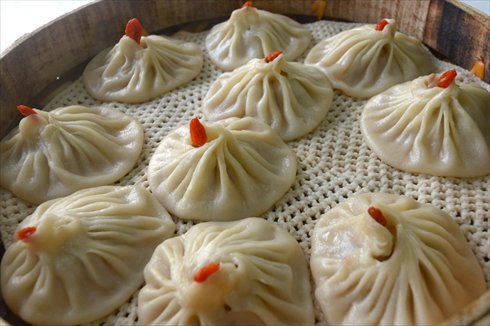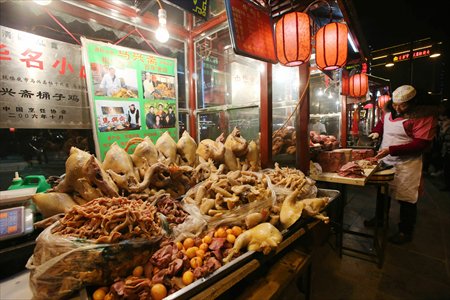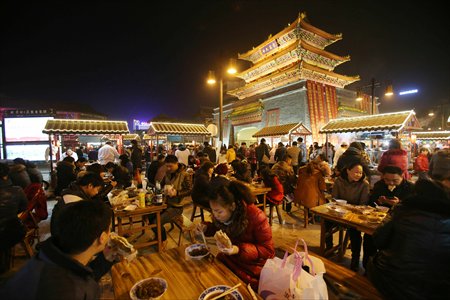Food safari

Guantang bao Photo: IC
Traveling can be as much about food as sightseeing. That's one reason people head to Kaifeng, Henan Province, one of China's ancient culinary and cultural capitals, known as "the birthplace of seven dynasties."
Cultural and historical relics are a highlight of Kaifeng, but it's also famous for its various delicacies.
Warming up breakfast
You should get up early to prepare for a full day of cultural tours in this city stuffed full of relics. And one thing you shouldn't miss for breakfast is Hu La Tang, spicy pepper soup.
The soup is said to go back to the Song Dynasty (960-1127). In the 16th century, it was introduced to the Jiajing Emperor by a monk. The ruler complimented it highly and named it as a "royal soup."
This brown colored, sticky soup is peppered and sour, full of slices of mutton or beef, chewy gluten, vermicelli, and seaweed. The dark color makes it look unappetizing, but the rich flavor and ingredients have made it a Henan-style staple on the breakfast table for centuries.
The rich flavor comes from various herbal ingredients including pepper, star anise, and ginger, together with the broth and mutton, which are nourishing and, in traditional Chinese thinking, raise body heat. Add one spoon of sesame oil to the bowl, and it's a perfect winter food.
This soup has many fitting mates. Deep-fried dough sticks, round flat cakes, and stuffed buns are all great choices. One tip: soak deep-fried dough sticks in the soup for a short time. The tender outside which absorbs the rich flavor from the soup, combined with the still crispy inside, taste amazing!
If all these flavors are too strong for you, there's a popular way to make it light - add half a bowl of watery tender bean curd. This is a combination of two delicious traditional Chinese breakfast choices, which, Henan locals call Liang Chaner.
Kaifeng is also famous for its donkey meat soup. It might sound unappetizing, but trust me, if my experience is anything to go by, all you need to do is try it once and you'll be hooked.
There is a saying in China, "dragon meat in heaven, donkey meat on Earth," implying that only heavenly food can compare with the taste of donkey. My gorge rose when I heard about eating donkey, but to my surprise, it tasted like beef, only better, when I actually tried it.
The Huasan Restaurant, an old and rather run-down building hidden in a winding back-alley, has the most famous donkey soup in the city. Every early morning, people line up outside it. If you can handle spicy food, then add one spoon of red pepper into the soup.
But you'll have to pick the right time. Just like school, the restaurant takes January-February off for the winter, and June to August in the summer.

A food stand at Gulou night fair Photo: IC
Power lunch
After a morning of walking, the best to refill your stomach is the famed Kaifeng's guantang bao, which is steamed buns with juicy stuffing.
Unlike traditional Chinese puffy buns, these are thin buns stuffed with liquid. This "soup" inside condenses the flavor of a meaty stuffing. When a basket of hot guantang bao is served, the first step is to drink the soup from the hole in the middle of the bun. After finishing the soup, then dip the bun in vinegar. The sour vinegar will slightly balance the greasy taste of the meaty buns.
To eat the most authentic guantang bao, picking the right restaurant is crucial. Di Yi Lou and Huangjia Baozi Pu are the two most time-honored spots. Built in the style of traditional architecture and serving all manner of famous Kaifeng dishes, these eateries are the best choice for tourists, which makes them inevitably crowded at peak time.
However, I suggest that you save some space in your stomach at lunch, because the night feast is the greatest part of eating in Kaifeng.

The Gulou night fair Photo: IC
Night fair
When the sky gets dark, hutongs empty during the day, light up. They are packed with numerous stands serving all kinds of snacks that you may never hear of. You can either eating while walking along the street or find a stand and sit on a chair on the side of the street. This is Kaifeng's night food fair.
It doesn't just attract tourists. People living in neighbouring cities will drive to Kaifeng on weekends to enjoy the night fair.
Most of the stands are gathered in two sites. The Gulou night fair which named from the drum tower in the center of the city, is the most bustling area of this city at night. It connects both the night fair for goods and the night fair for food.
Another one is the Xisi night fair next to the Bao Gong Lake. A walk along the lake after dinner is highly recommended. Some people say that people from outside the city prefer to go to Gulou night fair since it is more famous whereas locals prefer to choose Xisi since food there are better tastes at a more reasonable price.
Here you can choose from barbecue, fish hotpot, casserole, various staple food and desserts. I would particularly recommend picking some local delicacies you can't find elsewhere.
One dessert is on the list - almond tea. Kaifeng's almond tea is different from most places. It is made with almond powder, together with rice powder or lotus root starch, which make it much stickier than the norm.
On some traditional stands, they will pour the boiling water from a huge dragon-like bronze pot into the bowl of powders to add to the fun. After fully mixing the powder and water, almonds, black sesame, peanut, red and green sweets are sprinkled on the surface. That makes a perfect bowl of almond tea.